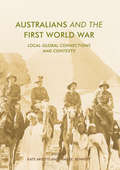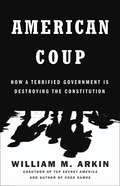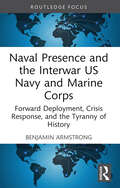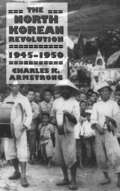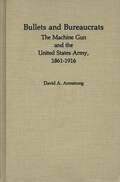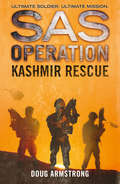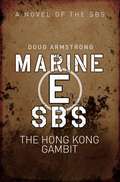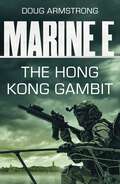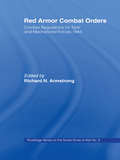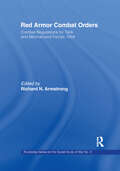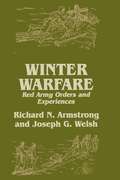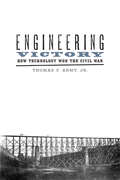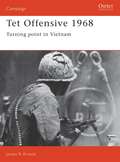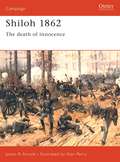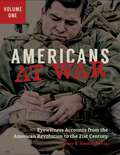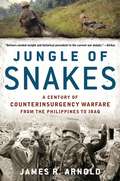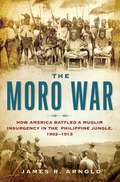- Table View
- List View
Australians and the First World War: Local-Global Connections and Contexts
by Kate Ariotti James E. BennettThis book contributes to the global turn in First World War studies by exploring Australians’ engagements with the conflict across varied boundaries and by situating Australian voices and perspectives within broader, more complex contexts. This diverse and multifaceted collection includes chapters on the composition and contribution of the Australian Imperial Force, the experiences of prisoners of war, nurses and Red Cross workers, the resonances of overseas events for Australians at home, and the cultural legacies of the war through remembrance and representation. The local-global framework provides a fresh lens through which to view Australian connections with the Great War, demonstrating that there is still much to be said about this cataclysmic event in modern history.
Australians and the First World War: Local-Global Connections and Contexts
by Kate Ariotti James E. BennettThis book contributes to the global turn in First World War studies by exploring Australians’ engagements with the conflict across varied boundaries and by situating Australian voices and perspectives within broader, more complex contexts. This diverse and multifaceted collection includes chapters on the composition and contribution of the Australian Imperial Force, the experiences of prisoners of war, nurses and Red Cross workers, the resonances of overseas events for Australians at home, and the cultural legacies of the war through remembrance and representation. The local-global framework provides a fresh lens through which to view Australian connections with the Great War, demonstrating that there is still much to be said about this cataclysmic event in modern history.
American Coup: How a Terrified Government Is Destroying the Constitution
by William M. ArkinA stunning exploration of the subtle erosion of freedom in an age of concocted fear and de facto military authority. When we think of a military coup, the first image that comes to mind is a general, standing at a podium with a flag behind him, declaring the deposing of elected leaders and the institution of martial law. Think again. In American Coup, William Arkin reveals the desk-bound takeover of the highest reaches of government by a coterie of "grey men" of the national security establishment. Operating between the lines of the Constitution, this powerful and unelected group fights to save the nation from "terror" and weapons of mass destruction while at the same time modifying and undermining the very essence of the country. Many books are written about secrecy, surveillance, and government law-breaking; none so powerfully expose the truth of everyday life in this state of war.
Blood Ties Book Four: All Souls' Night (A Bloodties Novel #4)
by Jennifer ArmintroutLove Sookie Stackhouse and Bella Swan? It's time to meet newly turned-vampire Carrie Ames.
Naval Presence and the Interwar US Navy and Marine Corps: Forward Deployment, Crisis Response, and the Tyranny of History (Corbett Centre for Maritime Policy Studies Series)
by Benjamin ArmstrongThis book examines the US Navy and Marine Corps during the interwar years from a new perspective. Rather than focusing on the technologies developed, the wargames conducted, or the results of the now famous Fleet Problems, this work analyzes the global deployments of the rest of the US fleet. By examining the annual reports of the Secretary of the Navy, the Chief of Naval Operations, and the Commandant of the Marine Corps over twenty years, the book traces the US ships, squadrons, and fleets conducting naval diplomacy and humanitarian missions, maritime security patrols, and deployments for deterrent effect across the world’s oceans. Despite the common label of the interwar years as “isolationist,” the deployments of the US Navy and Marine Corps in that period were anything but, the majority of the literature on the era has a narrow focus on preparation for combat and wartime, which provides an incomplete view of the history of US naval power and also establishes a misleading set of precedents and historical context for naval thinkers and strategists in the contemporary world. Offering a wider, and more complete understanding of the history of the U.S. Navy and Marine Corps from 1920 to 1939, this book demonstrates both the tension between the execution of peacetime missions and the preparation for the next war, while also offering a broader understanding of American naval forces and their role in American and global history. This book will be of much interest to students of naval and military history, seapower, and International History.
Naval Presence and the Interwar US Navy and Marine Corps: Forward Deployment, Crisis Response, and the Tyranny of History (Corbett Centre for Maritime Policy Studies Series)
by Benjamin ArmstrongThis book examines the US Navy and Marine Corps during the interwar years from a new perspective. Rather than focusing on the technologies developed, the wargames conducted, or the results of the now famous Fleet Problems, this work analyzes the global deployments of the rest of the US fleet. By examining the annual reports of the Secretary of the Navy, the Chief of Naval Operations, and the Commandant of the Marine Corps over twenty years, the book traces the US ships, squadrons, and fleets conducting naval diplomacy and humanitarian missions, maritime security patrols, and deployments for deterrent effect across the world’s oceans. Despite the common label of the interwar years as “isolationist,” the deployments of the US Navy and Marine Corps in that period were anything but, the majority of the literature on the era has a narrow focus on preparation for combat and wartime, which provides an incomplete view of the history of US naval power and also establishes a misleading set of precedents and historical context for naval thinkers and strategists in the contemporary world. Offering a wider, and more complete understanding of the history of the U.S. Navy and Marine Corps from 1920 to 1939, this book demonstrates both the tension between the execution of peacetime missions and the preparation for the next war, while also offering a broader understanding of American naval forces and their role in American and global history. This book will be of much interest to students of naval and military history, seapower, and International History.
The North Korean Revolution, 1945–1950 (Studies of the Weatherhead East Asian Institute, Columbia University)
by Charles K. ArmstrongNorth Korea, despite a shattered economy and a populace suffering from widespread hunger, has outlived repeated forecasts of its imminent demise. Charles K. Armstrong contends that a major source of North Korea's strength and resiliency, as well as of its flaws and shortcomings, lies in the poorly understood origins of its system of government. He examines the genesis of the Democratic People's Republic of Korea (DPRK) both as an important yet rarely studied example of a communist state and as part of modern Korean history. North Korea is one of the last redoubts of "unreformed" Marxism-Leninism in the world. Yet it is not a Soviet satellite in the East European manner, nor is its government the result of a local revolution, as in Cuba and Vietnam. Instead, the DPRK represents a unique "indigenization" of Soviet Stalinism, Armstrong finds. The system that formed under the umbrella of the Soviet occupation quickly developed into a nationalist regime as programs initiated from above merged with distinctive local conditions.Armstrong's account is based on long-classified documents captured by U.S. forces during the Korean War. This enormous archive of over 1.6 million pages provides unprecedented insight into the making of the Pyongyang regime and fuels the author's argument that the North Korean state is likely to remain viable for some years to come.
Bullets and Bureaucrats: The Machine Gun and the United States Army, 1861-1916 (Contributions in Military Studies)
by David A. Armstrong Jay Luvaas“This interesting account of the development of the machine gun takes the reader from the Gatling guns of the Civil War to the eve of WWI....This book provides an important look at the inability of military bureaucracy to rise above inertia and find a place for a demonstrably better weapon. It is highly recommended for all service schools and colleges with a large ROTC program; it will be a useful acquisition for all undergraduate libraries with a military history collection.”–Choice
Kashmir Rescue (SAS Operation)
by Doug ArmstrongUltimate soldier. Ultimate mission. But will the SAS be able to storm a terrorist stronghold in the mountains of Pakistan?
Marine E SBS: The Hong Kong Gambit (SBS)
by Doug ArmstrongAs British sovereignty over Hong Kong entered its final years, the prime concern of the colonial administration was to effect a smooth transition of power to China. But for the Triads, whose ruthlessness ensured their supremacy in the colony's thriving underworld, it was business as usual. Every night, crammed with contraband, their powerboats continued to run the gauntlet of police and Royal Marine patrols. For Sergeant Des Cooper of the Special Boat Squadron, a trip to Hong Kong offered a chance to revisit places he had got to know many years earlier. He jumped at the opportunity to accompany an anti-smuggling patrol, but during a search of a vessel he uncovered a cargo far less predictable than the electrical goods that were usually seized. Suddenly the spectre of nuclear weapons falling into the hands of terrorists looked menacingly real.Cooper and his highly trained team would risk their lives in their bid to crush a plot that threatened not only Hong Kong but the entire globe. This is classic military fiction at its best.
Marine E SBS: The Hong Kong Gambit (SBS)
by Doug ArmstrongAs British sovereignty over Hong Kong entered its final years, the prime concern of the colonial administration was to effect a smooth transition of power to China. But for the Triads, whose ruthlessness ensured their supremacy in the colony's thriving underworld, it was business as usual. Every night, crammed with contraband, their powerboats continued to run the gauntlet of police and Royal Marine patrols. For Sergeant Des Cooper of the Special Boat Squadron, a trip to Hong Kong offered a chance to revisit places he had got to know many years earlier. He jumped at the opportunity to accompany an anti-smuggling patrol, but during a search of a vessel he uncovered a cargo far less predictable than the electrical goods that were usually seized. Suddenly the spectre of nuclear weapons falling into the hands of terrorists looked menacingly real.Cooper and his highly trained team would risk their lives in their bid to crush a plot that threatened not only Hong Kong but the entire globe. This is classic military fiction at its best.
Marine E SBS: The Hong Kong Gambit (The Marine Files)
by Doug ArmstrongFor over eighty years the SBS have sailed into the face of danger. Responsible for quick strikes, reconnaissance, and counter-terrorism, they are the world's foremost marine special forces unit. The SBS risk their lives at sea and on land, undertaking the most dangerous missions. 1990s Hong Kong. With Britain about to cede control of Hong Kong to the Chinese, SBS operative Des Cooper is in town, taking part in anti-smuggling operations with the locals. But when rumours of a far-fetched plot to steal nuclear warheads prove true, Cooper and his SBS team must do their utmost to prevent all-out catastrophe.
Red Armour Combat Orders: Combat Regulations for Tank and Mechanised Forces 1944 (Soviet (Russian) Study of War)
by Richard N. ArmstrongSoviet military leadership is unable or unwilling to disassociate itself from past experiences. Red Armour Combat Orders illustrates through captured regulations that many of the Soviet Techniques in armoured warfare have remained unchanged over the last four decades. Study of the regulations provides a fundamental understanding of current Soviet armoured tactics and the ways in which they may develop.
Red Armour Combat Orders: Combat Regulations for Tank and Mechanised Forces 1944 (Soviet (Russian) Study of War)
by Richard N. ArmstrongSoviet military leadership is unable or unwilling to disassociate itself from past experiences. Red Armour Combat Orders illustrates through captured regulations that many of the Soviet Techniques in armoured warfare have remained unchanged over the last four decades. Study of the regulations provides a fundamental understanding of current Soviet armoured tactics and the ways in which they may develop.
Winter Warfare: Red Army Orders and Experiences (Soviet (Russian) Study of War)
by Richard N. Armstrong Joseph G. WelshBased on German and Soviet military archival material, this book provides an insight into the tactics and planning for combat in a winter climate. It also studies the mechanisms for change in an army during the course of battle.The first part of the book looks at the tactical pamphlet 'People's Commissar for Defence Order No. 109', as passed by Red Army units on 4 March 1941, which provided regulations for combat in Winter. The second part of the book, using material from the Soviet military archives, reveals Red Army General Staff supplements to the winter regulation.
Winter Warfare: Red Army Orders and Experiences (Soviet (Russian) Study of War #No. 8)
by Richard N. Armstrong Joseph G. WelshBased on German and Soviet military archival material, this book provides an insight into the tactics and planning for combat in a winter climate. It also studies the mechanisms for change in an army during the course of battle.The first part of the book looks at the tactical pamphlet 'People's Commissar for Defence Order No. 109', as passed by Red Army units on 4 March 1941, which provided regulations for combat in Winter. The second part of the book, using material from the Soviet military archives, reveals Red Army General Staff supplements to the winter regulation.
Engineering Victory: How Technology Won the Civil War (Johns Hopkins Studies in the History of Technology)
by Thomas F. Army Jr.Engineering Victory brings a fresh approach to the question of why the North prevailed in the Civil War. Historian Thomas F. Army, Jr., identifies strength in engineering;¢;‚¬;€?not superior military strategy or industrial advantage;¢;‚¬;€?as the critical determining factor in the war;€™s outcome.Army finds that Union soldiers were able to apply scientific ingenuity and innovation to complex problems in a way that Confederate soldiers simply could not match. Skilled Free State engineers who were trained during the antebellum period benefited from basic educational reforms, the spread of informal educational practices, and a culture that encouraged learning and innovation. During the war, their rapid construction and repair of roads, railways, and bridges allowed Northern troops to pass quickly through the forbidding terrain of the South as retreating and maneuvering Confederates struggled to cut supply lines and stop the Yankees from pressing any advantage.By presenting detailed case studies from both theaters of the war, Army clearly demonstrates how the soldiers;€™ education, training, and talents spelled the difference between success and failure, victory and defeat. He also reveals massive logistical operations as critical in determining the war;€™s outcome.
Engineering Victory: How Technology Won the Civil War (Johns Hopkins Studies in the History of Technology)
by Thomas F. Army Jr.Engineering Victory brings a fresh approach to the question of why the North prevailed in the Civil War. Historian Thomas F. Army, Jr., identifies strength in engineering;¢;‚¬;€?not superior military strategy or industrial advantage;¢;‚¬;€?as the critical determining factor in the war;€™s outcome.Army finds that Union soldiers were able to apply scientific ingenuity and innovation to complex problems in a way that Confederate soldiers simply could not match. Skilled Free State engineers who were trained during the antebellum period benefited from basic educational reforms, the spread of informal educational practices, and a culture that encouraged learning and innovation. During the war, their rapid construction and repair of roads, railways, and bridges allowed Northern troops to pass quickly through the forbidding terrain of the South as retreating and maneuvering Confederates struggled to cut supply lines and stop the Yankees from pressing any advantage.By presenting detailed case studies from both theaters of the war, Army clearly demonstrates how the soldiers;€™ education, training, and talents spelled the difference between success and failure, victory and defeat. He also reveals massive logistical operations as critical in determining the war;€™s outcome.
Mercenaries: Scourge of the Developing World
by Guy ArnoldMercenaries have been employed as auxiliaries since early times, but in the post-1945 world they have operated, almost exclusively, in weak Third World countries. From Columbia to the Congo, Angola to Papua New Guinea, Cambodia to Nicaragua, they have appeared: training the drug cartel armies, assisting rebellions or civil wars, acting as the agents of the major powers. In the Congo crisis (1960-1965) they earned an especially unsavory reputation for greed, brutality and racism; it is a reputation that has stuck to the mercenary and on the whole justly. During the 1990s a new phenomenon has emerged in the form of the mercenary corporations such as Executive Outcomes or Sandline. These corporations offer a range of military expertise and weaponry, have the covert support of governments in the countries from which they come and are rapidly becoming a power to themselves, ultimately far more dangerous than the individual freebooters of the past.
Tet Offensive 1968: Turning point in Vietnam (Campaign)
by James ArnoldThe 1968 Tet Offensive was the decisive battle for Vietnam. Masterminded by the brilliant North Vietnamese General, Vo Nguyen Giap, it was intended to trigger a general uprising in South Vietnam. However, the bloody fighting for Saigon, Hue and other cities actually resulted in a catastrophic defeat for the North. In this excellent assessment of the key battle of the Vietnam conflict, James Arnold details the plans and forces involved and explains how, despite the outcome of the battle, the American people and their leaders came to perceive the war for Vietnam as lost.
Tet Offensive 1968: Turning point in Vietnam (Campaign #4)
by James ArnoldThe 1968 Tet Offensive was the decisive battle for Vietnam. Masterminded by the brilliant North Vietnamese General, Vo Nguyen Giap, it was intended to trigger a general uprising in South Vietnam. However, the bloody fighting for Saigon, Hue and other cities actually resulted in a catastrophic defeat for the North. In this excellent assessment of the key battle of the Vietnam conflict, James Arnold details the plans and forces involved and explains how, despite the outcome of the battle, the American people and their leaders came to perceive the war for Vietnam as lost.
Shiloh 1862: The death of innocence (Campaign)
by James Arnold Alan PerryThe first major battle in the Western theatre of the American Civil War, Shiloh came as a horrifying shock to both the American public and those in arms. For the first time they had some idea of the terrible price that would be paid for the preservation of the Union. On 6 April 1862 General Albert Sidney Johnston caught Grant and Sherman by surprise and very nearly drove them into the River Tennessee, but was mortally wounded in the process. Somehow Grant and Sherman hung on and the next day managed to drive back the hordes of grey-clad rebels.
Americans at War [3 volumes]: Eyewitness Accounts from the American Revolution to the 21st Century [3 volumes]
by James R. ArnoldThis unprecedented compilation of eyewitness accounts records the thoughts and emotions of American soldiers spanning nearly 250 years of national history, from the American Revolution to the Afghanistan War.Understanding primary sources is essential to understanding warfare. This outstanding collection provides a diverse set of eyewitness accounts of Americans in combat throughout U.S. history. Offering riveting true stories, it includes accounts from participants in the American Revolution, the War of 1812, the Indian Wars, the Mexican-American War, the Civil War, the Spanish American War and Philippine Insurrection, World War I, World War II, the Korean War, the Vietnam War, The Persian Gulf War, the Afghanistan War, and the Iraq War.Most eyewitness accounts of war currently available to the public are those of writers who enjoy higher military rank. Americans at War addresses this imbalance between officers' accounts and enlisted men's accounts by invoking oral history archives. Contextual essays and timelines allow the reader to place the accounts in time and place, while the entries themselves allow the reader to experience the thoughts and emotions of Americans who engaged in combat.
Jungle of Snakes: A Century of Counterinsurgency Warfare from the Philippines to Iraq
by James R. ArnoldThe end of the Cold War promised a new, more peaceful era was at hand. But with the escalation of violence by terrorists, insurgents, and guerillas, former CIA director James Woolsey said "After forty-five years of fighting a dragon we finally killed it, and now instead, we find ourselves standing in a jungle with a bunch of snakes." The emergence of a fresh set of conflicts has forced militaries across the world to reevaluate their strategies or risk never-ending conflicts with insurgencies. James Arnold traces the successes and failures of counter-insurgency in the 20th century. He examines the US in the Philippines, the British in Malaysia, the France in Algeria, and the US in Vietnam, with an epilogue that looks at Iraq, where American generals are striving to apply the lessons of the previous conflicts. In A Jungle Full of Snakes, Arnold shows that the tug of war over civilian support and the build up of a strong central government are crucial victories for any attempted counter-insurgency.
The Moro War: How America Battled a Muslim Insurgency in the Philippine Jungle, 1902-1913
by James R. ArnoldAs the global war on terror enters its second decade, the United States military is engaged with militant Islamic insurgents on multiple fronts. But the post-9/11 war against terrorists is not the first time the United States has battled such ferocious foes. The forgotten Moro War, lasting from 1902 to 1913 in the islands of the southern Philippines, was the first confrontation between American soldiers and their allies and a determined Muslim insurgency.The Moro War prefigured American wars in Iraq and Afghanistan more than superficially: It was a bitter, drawn-out conflict in which American policy and aims were fiercely contested between advocates of punitive military measures and proponents of conciliation.As in today's Middle East, American soldiers battled guerrillas in a foreign environment where the enemy knew the terrain and enjoyed local support. The deadliest challenge was distinguishing civilians from suicidal attackers. Moroland became a crucible of leadership for the U.S. Army, bringing the force that had fought the Civil War and the Plains Indian Wars into the twentieth century. The officer corps of the Moro campaign matured into the American generals of World War I. Chief among them was the future general John Pershing-who learned lessons in the island jungles that would guide his leadership in France.Rich with relevance to today's news from the Middle East, and a gripping piece of storytelling, The Moro War is a must-read to understand a formative conflict too long overlooked and to anticipate the future of U.S. involvement overseas.
